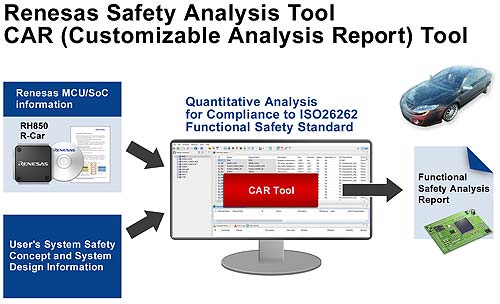 Renesas Electronics Corporation is announcing the release of the GUI CAR (Customizable Analysis Report) Tool, an innovative safety analysis tool that will enhance customers’ ability to quickly integrate Renesas products into their safety-critical automotive systems while increasing user confidence in system compliance to the latest safety standard. The powerful new FMEDA (failure mode effects and diagnostics analysis) tool is optimized for the ISO 26262 standard, which addresses safety of electrical and/or electronic systems within road vehicles, and is the target for compliance of this revolutionary product.
Renesas Electronics Corporation is announcing the release of the GUI CAR (Customizable Analysis Report) Tool, an innovative safety analysis tool that will enhance customers’ ability to quickly integrate Renesas products into their safety-critical automotive systems while increasing user confidence in system compliance to the latest safety standard. The powerful new FMEDA (failure mode effects and diagnostics analysis) tool is optimized for the ISO 26262 standard, which addresses safety of electrical and/or electronic systems within road vehicles, and is the target for compliance of this revolutionary product.
As part of its functional safety support program, Renesas offers extensive portfolio of semiconductor products, software, solutions, and tooling in virtually every automotive application. As the newest member to this program, the CAR Tool addresses a very common market problem: How to adapt a general SEooC (Safety Element out of Context) safety analysis report to align with the final application-specific use case and the need to support several safety goals for one item.
“This is a tool developed by safety engineers, deeply involved with the creation of the ISO26262 standard since the beginning, for safety engineers,” said Riccardo Vincelli, Director of the Functional Safety Competence Center, Renesas. “It is the result of intensive internal activity to find solutions for daily challenges associated with efficient safety analysis, effective exchange of results with stakeholders, and customization based on different use cases.”
The CAR Tool unifies key aspects of the safety analysis by offering a multi-layered view of the safety-related component, complete with customizable analysis parameters and all of the results required by ISO 26262, such as single point fault metric (SPFM) and latent fault metric (LFM). This innovative tool also provides the user with estimations for both probabilistic metric for random hardware failures (PMHF) and its evaluation of each cause of safety goal violation. These results can be displayed from the entire component down to each single element via different hierarchical levels, accurately splitting its FIT in the appropriate fault class (single-point, residual, latent, etc.) This also makes it easy and effective to browse complex system-on-chip (SoC)/microcontroller (MCU) safety analyses.
For a given product, the provided library can be customized to different applications, precisely configured to match the usage of the component in the target system. A powerful GUI is the window for visibility into the product, and for obtaining and configuring safety related information. FIT characteristics, fault characterization, failure modes, fault impact, and fault coverages are just some of the parameters under user control.
These features make the CAR Tool from Renesas the safety analysis tool of choice for an accurate, unified, and cohesive analysis of a component or system with the flexibility of customization for any application context.
Key features of the new GUI Tool
- Effective Graphical User Interface (GUI) for clear visibility and ease of customization
- Library import for Renesas components
- Possibility to create and share libraries between parties or from other suppliers
- Automatic calculation of ISO26262 HW architectural metrics
- Automatic calculation of PMHF and alternate method
- Handling of different Safety Goals
- Handling of different use cases
- Configuration of a golden library with a high degree of customization for different application profiles.
- Accurate revision control and change history support
- Error logging
- Embedded documents and references
- Possibility to customize many safety related parameters including:
- Fault characterization
- Failure modes
- Fault impact
- FIT characterization and allocation
- Safety-related status
- Safety mechanisms
- Fault coverage
Renesas Electronics Corporation | www.renesas.com


